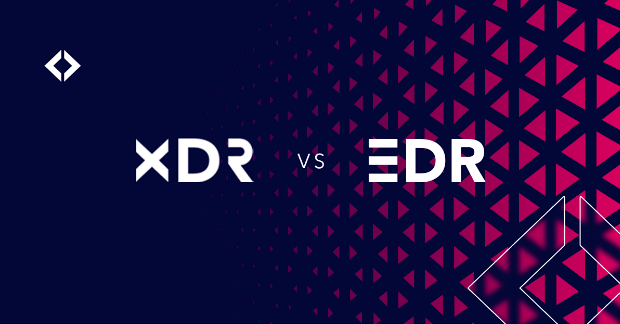Today, EDR XDR are two common acronyms in the cybersecurity industry. More and more enterprises are highly reliant on these emerging endpoint security technology.
Surprisingly more than 70% of breaches originate from endpoints
IT Department considers navigation through the vendor landscape a big challenge. They want to know what cyber security solution is right for them. When it comes to the detection and response on all the corporate endpoints, the biggest hurdle is the complete understanding of EDR and XDR.
Before a team gets a solution, they should know what every option provides. Let's dive into the details of both options and their capabilities.

What is EDR?
It is an acronym for Endpoint detection and response system designed to overcome the shortcoming of traditional security solutions. This software monitors all endpoints to detect, prevent, and respond to known and unknown threats.
The problem is that organizations believe that antivirus is good enough to secure their endpoints, while the reality is far different. Antivirus is a reactive approach that detects potential security threats by matching new file codes with known patterns and signatures of malware.
An endpoint detection tool is a predictive and proactive approach to endpoint security.
It can identify advanced threats and never-before-seen malware by continuously monitoring and analyzing all the activities.
You can find many EDR solutions in the market, such as Xcitium, SentiOne, Crowdstrike, and many others.
Most tools make the most of various advanced technologies to detect new and emerging threats, such as:
- Cyber threat intelligence
- Advanced file analysis
- Machine learning algorithm
How Endpoint Detection and Response System Work?
Once an agent is installed, it will start recording and storing behavior, security events, and queries in a centralized dashboard. Your cybersecurity team can detect and analyze malicious activities over time.
What if an attack happens? In that case, the tool will contain the threat and isolate the infected endpoint. Thereby, malware attacks won't spread from one compromised endpoint to another. It's how the software safeguards the complete network.
Malicious files are detained in a safe environment, commonly known as Sandbox. This software helps your in-house team in an in-depth analysis of a security event. Fast incident response is a big plus of this solution.
What is XDR?
XDR is an acronym for Extended Detection And Response. It is another renowned endpoint solution. When you compare XDR and EDR, you find that XDR is a more evolved and multi-platform security measure than EDR.
EDR is designed to create an extra layer of protection across all endpoints. But the Extended detection tool extends its protection level to cross-platform such as cloud workloads, SIEM, networks, endpoints, servers, and much more.
Your organization typically installs different software to protect all these platforms. But Once you have XDR, you get unified and single-panel protection. From one dashboard, you can explore multiple tools and attack vectors.
How does Extended Detection Software work?
It collects data and logs from all platforms using the latest technologies, such as automation, artificial intelligence, and machine learning. The purpose of this unified system is to offer accurate alerts to security teams so they don't have to feel overwhelmed with false positive alerts.
Besides, it offers contexts of threats across all attack surfaces; your team can look into them and fix the vulnerabilities in the cross-platform effortlessly.
EDR XDR- Comparing the Both Cyber Security Solutions
Before your IT Team decides what option you need to get, it's better to compare EDR XDR in the best manner and then go with one that seems ideal for your organization.
Platform
The major difference between both solutions is their platform. You can protect all the endpoints with EDR, and that's it. No other platform gets a security shield from this tool.
On the flip side, XDR offers next-level protection because it lets you secure endpoints, networks, cloud workstations, and much more.
Which one is better? When you need a dedicated tool for an endpoint, Xcitium EDR is the best one. However, when you need the safety of a complete network, this job can be done well by only Xcitium XDR.
Data Collection
EDR doesn't offer comprehensive protection to your enterprise because the data it collects is only from a few endpoints. XDR ingests a huge amount of data from cross-platform. So, if an attack bypasses an endpoint and penetrates your network, the endpoint detection tool won't identify it.
But your team can see attackers across all platforms and networks when you have Extended Detection and Response software. Thereby they will get better visibility and a chance to prevent attacks.
You have limited visibility into threats with EDR as you may miss detection or deal with longer investigation time or false positives. However, you can get an ultimate solution to all shortcomings with an XDR.
